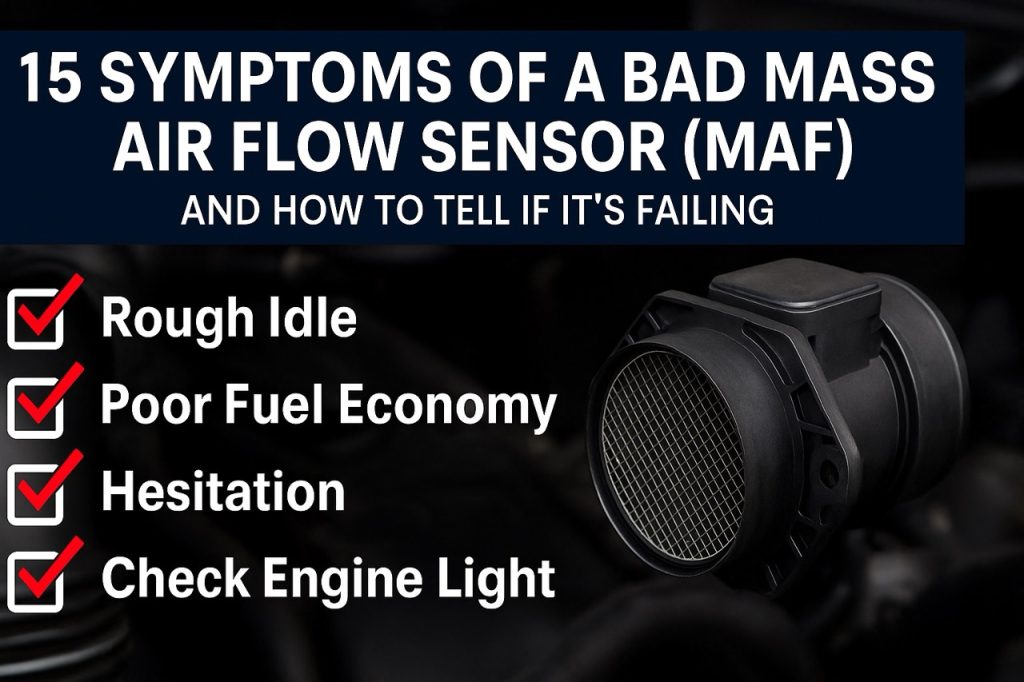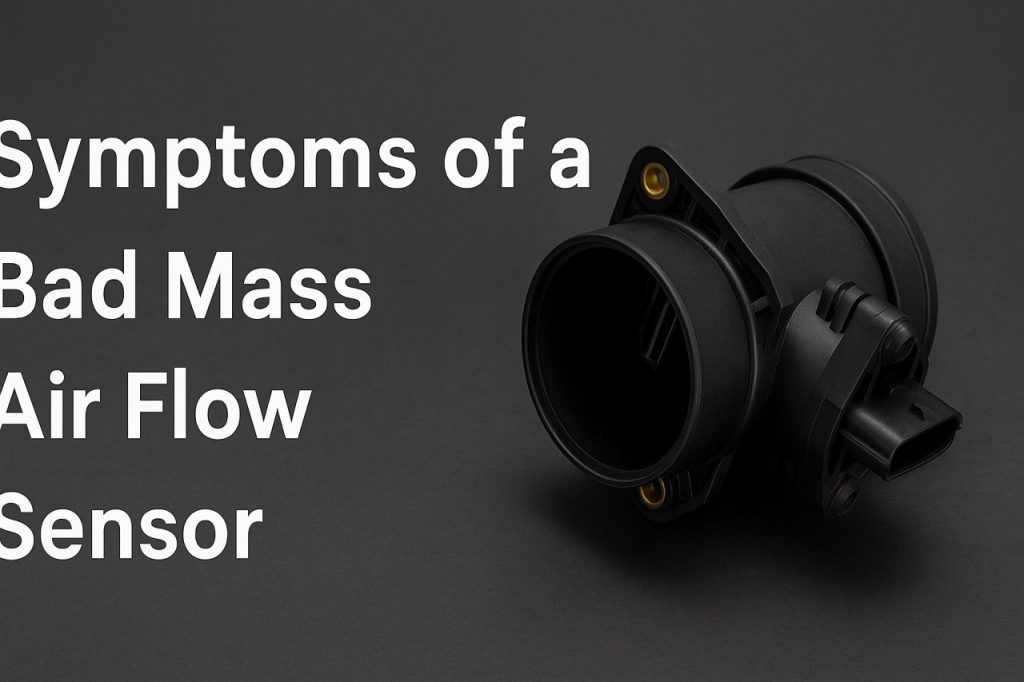what are the Symptoms of a Bad Mass Air Flow Sensor: The mass air flow sensor (MAF sensor) is one of the most important components in your car’s engine management system. Its job is simple but critical: it measures how much air is entering the engine so that the ECU (engine control unit) can deliver the correct amount of fuel. When the sensor is working properly, the engine runs smoothly, delivers optimal fuel economy, and produces minimal emissions. what are the symptoms of a bad mass air flow sensor
But when the sensor gets dirty or begins to fail, the problems show up quickly. The symptoms of a bad mass air flow sensor often include rough idling, hesitation, poor fuel economy, or even stalling. Many drivers confuse these issues with other problems, like a clogged fuel injector or bad spark plugs, which is why identifying the true cause is so important.
Catching early MAF sensor symptoms can save you hundreds of dollars in repairs. In some cases, a simple cleaning with the right maf sensor cleaner is all that’s needed, while ignoring the problem can lead to more serious mass air flow sensor issues, including catalytic converter damage. Replacing a bad sensor can cost anywhere from $150 to $400, depending on the car, while cleaning typically costs under $20 if you do it yourself.
In this guide, we’ll cover the 15 most common symptoms of a bad mass air flow sensor, explain the difference between dirty vs failing sensors, and show you exactly how to tell if mass airflow sensor is bad before it becomes a major expense.
what are the symptoms of a bad mass air flow sensor
Table of Contents

What Does the Mass Air Flow Sensor Do?
Before diving into the bad MAF sensor symptoms, it helps to understand the sensor’s role in your vehicle.
The mass air flow sensor sits in the intake system, usually between the air filter and the throttle body. As air flows into the engine, the sensor measures the volume and density of that air. It then sends this data to the ECU, which calculates the perfect air-fuel ratio for combustion. This balance is crucial: too much fuel (running rich) wastes gas and damages components, while too little fuel (running lean) causes hesitation and poor performance.
Clean vs Dirty Sensor
When the MAF sensor is clean, the ECU receives accurate data, leading to smooth performance. But over time, dust, pollen, oil vapors, or carbon particles can build up on the delicate wires or film inside the sensor. These deposits cause incorrect readings. A dirty mass air flow sensor doesn’t fail completely right away, instead, it starts showing subtle issues like rough idle or a drop in fuel economy. These are the early dirty mass air flow sensor symptoms that many drivers overlook.
If ignored, the problem escalates into full mass air flow sensor failure symptoms. At this stage, the sensor may send wildly inaccurate readings or none at all, leaving the ECU blind. The result is hard starting, engine stalling, and to airflow or fuel trim problems.
Why Issues Matter
Even though the MAF sensor is small, any mass air flow sensor issues have a domino effect on your engine. Incorrect data from the sensor causes the ECU to make poor fuel adjustments, which can:
- Damage spark plugs.
- Increase emissions.
- Reduce engine lifespan.
- Cause costly catalytic converter failures.
That’s why learning the signs of a bad mass air flow sensor early is so important. By understanding the difference between a dirty sensor and a failing one, you can take action quickly, whether that means cleaning the sensor or replacing it altogether.
15 Common Symptoms of a Bad Mass Air Flow Sensor
The most reliable way to recognize symptoms of a bad mass air flow sensor is by watching for changes in the way your car runs. Since the MAF directly controls the air-fuel ratio, almost every symptom relates to how your engine starts, idles, accelerates, or consumes fuel.
Here are the 15 most common bad MAF sensor symptoms you should know:
1. Rough Idle and Stalling
One of the most common dirty mass air flow sensor symptoms is a rough idle. When the sensor misreads airflow, the ECU injects the wrong amount of fuel, causing uneven combustion. This makes the car shake, sputter, or even stall when stopped at traffic lights.
2. Poor Fuel Economy
A failing MAF often causes the engine to run rich (too much fuel), leading to significantly worse gas mileage. If you find yourself filling up more often without a change in driving habits, this is a classic bad MAF sensor symptom.
3. Hesitation or Jerking When Accelerating
When the MAF sensor fails to deliver accurate data, acceleration feels unsteady. You may notice hesitation when pressing the gas or sudden jerks, especially when merging or overtaking. These maf sensor symptoms are often mistaken for transmission issues.
4. Loss of Engine Power
A weak or failing MAF can cause the engine to run lean (too little fuel). This results in sluggish performance, lack of power climbing hills, or struggling to maintain highway speeds. Many drivers describe this as their car “feeling heavy.”
5. Difficulty Starting
In some cases, especially with a failing sensor, the ECU cannot determine the proper fuel mixture for ignition. This makes the engine hard to start or crank longer than usual. These are typical mass air flow sensor failure symptoms.
6. Check Engine Light
One of the first warnings may be a glowing check engine light. Diagnostic scans often show codes like P0100, P0101, or P0102, all linked to airflow readings. If paired with other bad MAF symptoms, this is a strong indicator the sensor is at fault.
7. Dark Exhaust Smoke
If the ECU is dumping excess fuel due to incorrect MAF readings, unburnt fuel exits through the exhaust. This creates black or dark gray smoke, a sign of running rich. This is both a performance issue and an emissions problem.
8. Unstable RPMs at Idle
When the sensor is dirty or failing, the engine speed may fluctuate even while the car is stationary. You might see the tachometer needle bounce between high and low RPMs without touching the gas.
9. Hard Shifting in Automatic Cars
Some modern transmissions rely on MAF data to optimize shifting. If airflow readings are off, gear changes can feel abrupt or delayed. While this is less common, it still qualifies as one of the symptoms of a bad MAF sensor.
10. Engine Surging at Highway Speeds
Another frustrating issue is sudden surges or drops in power when cruising. This happens because the MAF sensor is sending inconsistent airflow data, confusing the ECU. The result is a lurching or surging feeling at steady speeds.
11. Engine Misfires
Incorrect air-fuel mixtures often cause misfires, felt as a sharp jolt or popping sound. Left unchecked, repeated misfires from a bad mass air flow sensor can damage spark plugs and catalytic converters.
12. Strong Fuel Smell
If the ECU injects too much fuel, you may notice a raw gasoline smell from the exhaust or under the hood. This is a dangerous symptom, as it signals incomplete combustion.
13. Reduced Throttle Response
Drivers often describe a “lag” between pressing the gas pedal and the engine responding. This lag is another one of the clear bad maf sensor symptoms.
14. Engine Stalls After Starting
Sometimes the car starts normally but stalls within seconds. This happens because the ECU receives no accurate airflow signal once the engine is idling.
15. Limp Mode Activation
In severe cases, the ECU may put the car into “limp mode” to protect the engine. This restricts speed and power output. If your car suddenly loses acceleration and won’t go past a certain RPM, the MAF could be the cause.
In short, bad MAF sensor symptoms range from mild (poor fuel economy, rough idle) to severe (stalling, limp mode). Recognizing them early can save you from bigger problems down the road. Also read this on What Causes Mass Air Flow Sensor to Go Bad?
Dirty vs Bad MAF Sensor Symptoms: What’s the Difference?
It’s important to distinguish between a dirty mass air flow sensor and a completely failing sensor.
- Dirty Mass Air Flow Sensor Symptoms:
- Rough idle.
- Poor fuel economy.
- Hesitation during acceleration.
- Check engine light with mild performance issues.
These are often solved by removing the sensor and using a proper maf sensor cleaner. In many cases, cleaning restores normal function.
- Bad Mass Air Flow Sensor Symptoms (Complete Failure):
- Car stalls or won’t start.
- Severe loss of power.
- Surging or limp mode.
- Persistent check engine light with airflow-related error codes.
These indicate the sensor is beyond cleaning and must be replaced.
In other words, cleaning may resolve some maf failure symptoms, but when the sensor is physically damaged or electrically dead, replacement is the only option.

Signs of a Mass Air Flow Sensor Going Bad Over Time
Not every sensor fails overnight. Often, the symptoms of a mass air flow sensor going bad appear gradually, making them harder to pinpoint until the problem becomes severe.
Slow Progression of Symptoms
- In the early stages, you may only notice slightly worse fuel economy or a subtle rough idle.
- As time passes, hesitation during acceleration, stalling, or frequent misfires begin to occur.
- Eventually, you’ll face more serious maf failure symptoms such as limp mode, complete loss of power, or inability to start the engine.
Intermittent Issues
One reason drivers overlook the signs of a mass air flow sensor going bad is because the issues can be inconsistent. For example:
- The car may run fine when the engine is cold but misbehave once it warms up.
- Problems may only appear under heavy acceleration or highway cruising.
- Seasonal changes (hot vs cold air) can worsen or mask the symptoms.
This inconsistency is what makes diagnosing maf sensor failure symptoms tricky without proper testing.
Why Gradual Decline Happens
- Dirt and oil buildup slowly interfere with airflow readings.
- Heat cycles degrade sensitive electronic components.
- Loose connections or aging wiring add to the problem.
If caught early, cleaning might restore function. But once wear reaches a critical point, the only fix is sensor replacement.
How to Tell If Mass Airflow Sensor Is Bad (Diagnosis Tips)
When performance issues appear, many drivers ask: how to tell if mass airflow sensor is bad and not some other part. Luckily, there are several ways to diagnose it.
1. Use an OBD-II Scanner
- Plugging in a scanner can reveal trouble codes like P0100, P0101, or P0102, which all point to mass air flow sensor issues.
- Live data mode lets you check if airflow readings match engine load. Unusual or flat readings suggest a failing sensor.
2. Perform a Visual Inspection
- Locate the sensor (usually between the air filter box and throttle body).
- Remove it carefully and check for dirt, oil, or carbon buildup on the wires or hot film.
- A visibly dirty sensor often produces dirty mass air flow sensor symptoms, which may improve after cleaning.
3. Try the Unplug Test
- With the engine idling, disconnect the sensor’s electrical plug.
- If the car suddenly runs better or smoother, it’s a strong sign the sensor is faulty. The ECU defaults to pre-set values, bypassing the bad readings.
*Note: This is only a quick test. It may trigger a check engine light and should not be used as a permanent fix.
4. Compare Cold vs Hot Engine Performance
- If problems only show when the engine is hot, it may indicate failing internal electronics.
- This pattern matches the gradual maf failure symptoms often seen in aging sensors.
*Together, these tests give a clear answer to the query: how to tell if mass airflow sensor is bad.
Related Mass Air Flow Sensor Issues
It’s important to note that not all maf sensor symptoms mean the sensor itself is bad. Other components can mimic the same problems, which is why drivers sometimes replace the sensor unnecessarily.
Here are the most common mass air flow sensor issues that aren’t caused by the sensor:
- Vacuum Leaks: Cracks or leaks in hoses let unmetered air into the intake. The ECU thinks the MAF sensor is faulty when it’s actually a leak.
- Clogged Air Filter: A dirty filter restricts airflow, triggering the same rough idle, hesitation, and poor fuel economy as a failing sensor.
- Oxygen (O2) Sensor Failure: Since the O2 sensor also regulates air-fuel mixture, its failure can produce symptoms identical to bad MAF sensor symptoms.
- Throttle Body Issues: Carbon buildup on the throttle body can mimic airflow problems.
- Fuel Delivery Problems: A weak fuel pump or clogged injectors cause hesitation and power loss that resemble maf sensor symptoms.
Always confirm the root cause before replacing the sensor. Sometimes a simple air filter replacement or hose repair solves what seems like a mass air flow sensor failure symptom.
What Happens If You Ignore Bad MAF Sensor Symptoms?
It’s tempting to dismiss early maf sensor symptoms as minor annoyances, but ignoring them can have serious consequences. A bad or dirty sensor doesn’t just make your car run poorly, it can cause lasting damage to key components.
Engine Damage Risk
When the ECU receives incorrect airflow data, it miscalculates the fuel mix. Running too rich can wash down cylinder walls with excess fuel, while running too lean can cause detonation and overheating. Both scenarios shorten the life of pistons, valves, and spark plugs.
Catalytic Converter Failure
One of the most expensive outcomes of untreated mass air flow sensor failure symptoms is catalytic converter damage. If the engine constantly runs rich, unburnt fuel burns inside the converter, overheating and breaking it down. A replacement converter can cost $1,000 to $2,500.
Higher Fuel Costs
Bad MAF readings often make the engine inject more fuel than needed. Over time, this can drain your wallet at the pump. Many drivers only realize the connection between poor MPG and bad MAF sensor symptoms after wasting hundreds on extra gas.
Bottom line: ignoring the symptoms of a mass air flow sensor going bad leads to higher repair bills, poor performance, and long-term damage that could have been avoided.
Quick Fixes and Next Steps
The good news is that many mass air flow sensor issues are fixable without major expense if caught early.
1. Try Cleaning First
Often, dirty mass air flow sensor symptoms can be resolved with a thorough cleaning. A dedicated maf sensor cleanerspray (such as CRC Mass Air Flow Sensor Cleaner) dissolves dirt and oil without damaging the sensor. Cleaning typically costs under $15 and takes less than 30 minutes.
For a full step-by-step guide, see our article: How to Clean Mass Air Flow Sensor for Better Fuel Economy.
2. When to Replace
If cleaning doesn’t solve the issue, or if the sensor is physically damaged or electrically dead, replacement is the only option. New sensors typically cost:
- $80–$150 for aftermarket parts.
- $200–$400 for OEM replacements, plus labor.
3. Cost Comparison
- Cleaning: under $20 DIY.
- Replacement: $200–$400 average.
That’s why addressing bad maf sensor symptoms early is so important, you might save hundreds by cleaning instead of replacing.
Conclusion
The symptoms of a bad mass air flow sensor can start small, rough idle, hesitation, or poor fuel economy — but quickly escalate to serious performance problems, dark exhaust smoke, and even stalling. The most common maf sensor symptoms include:
- Rough idle and stalling.
- Poor fuel economy.
- Hesitation or jerking when accelerating.
- Check engine light with airflow codes.
Recognizing these signs early helps you avoid major mass air flow sensor issues like engine damage or catalytic converter failure. In many cases, a simple cleaning with a quality maf sensor cleaner restores proper function and keeps repair costs low.
Don’t ignore the warning signs. Diagnose early, clean or replace when needed, and keep your engine running smoothly.
Next steps:
- Read our guide on How to Test a Mass Air Flow Sensor for DIY diagnostics.
- Learn the safest method for How to Reset a Mass Air Flow Sensor after repair.
- Check our full review of the Best MAF Sensor Cleaners to choose the right produc
- Best Mass Air Flow Sensor Cleaner Spray: CRC vs Alternatives
